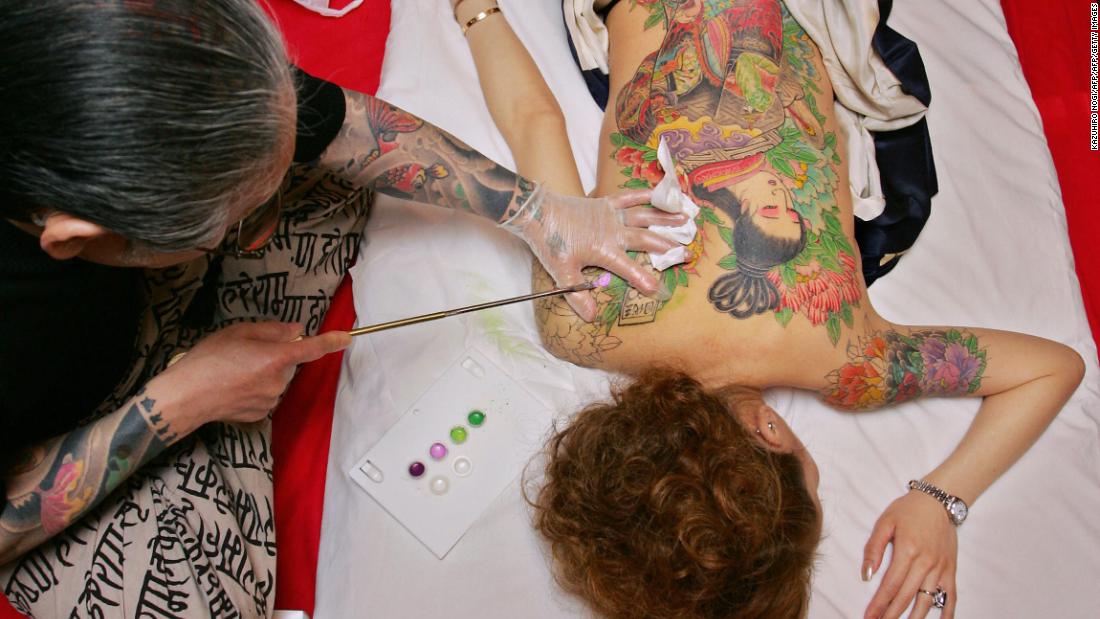Body art has become a form of self-expression. When visible, they tell the world something about you and what you like, about what you believe and value. Tattoos also pay homage to loved ones, permanently enshrining the names of lovers, precious children or dates of special significance.
While the popularity of tattoos has grown, regulation of the industry has not. Tattoo ink is not regulated by the federal government. And oversight of tattoo parlors and artists on the state and local level is spotty.
And even in the best of circumstances, there are real dangers in both the inking process and the self-care of the wounds.
“We see people come into our clinic with some bad tattoo reactions,” said Dr. Crystal Aguh, an assistant professor of dermatology at Johns Hopkins University School of Medicine.
“You’re introducing a foreign body via the skin and there are risks,” said Dr. Shawn Kwatra, also an assistant professor of dermatology at Johns Hopkins. “Sometimes your body can react in many ways you may have never thought about.”
Allergic reactions
Tattoos can trigger allergic reactions; the most common is to ink. The reaction can be to any color, but the most typical are yellow and red.
Yellow ink is associated with sun sensitivity, which can be irritating because you have to cover up your tat to protect it. But the photosensitivity typically fades after a few years, Aguh said.
A reaction to red ink, however, is most common. For many, the response is mild: a bit of redness, swelling or an itch that can be treated with a steroid cream.
For some, red ink can spark a potentially serious allergic reaction, turning the tattoo experience into a nightmare.
Pimple-like bumps, blisters, and raised, scaly patches that flake off can appear. There could also be a watery discharge from the site.
If those signs are paired with troubled breathing, or you experience a racing heart, dizziness, stomachache, serious pain, flushing or hives, seek medical care immediately.
In rare cases, people can get neurodermatitis, also known as lichen simplex chronicus.
“It’s a persistent, almost chronic-like inflammation, which causes your whole tattoo to bubble up where the pigment is and become like thick, leathery skin,” Aguh said.
Treatment is usually effective, she said. But for some it fails and leads to disfigurement.
How do you know if you’ll have an allergic reaction or how serious it might be? Unfortunately you won’t, which is why dermatologists recommend first getting a tiny test tattoo in a spot that isn’t visible.
“You may be completely normal, completely healthy, but there could be something about the red pigment that your body just does not like,” Aguh said. “If you’ve never been exposed to it before there would be no way for you to know before getting the tattoo.”
Lymph nodes
In Australia, doctors were treating a woman for a type of cancer called lymphoma. She had lumps under her arms, as well as enlarged lymph nodes near the roots of her lungs, all classic signs of the cancer.
Their most disturbing discovery, however, was toxic heavy metals in the lymph nodes, including cobalt, nickel and chromium. Heavy metals are sometimes added to tattoo pigment as preservatives.
The FDA considers tattooing to be a cosmetic procedure, so it doesn’t regulate the industry. But it does look into adverse reactions.
Katz said the agency is analyzing tattoo inks and pigments for “heavy metals, degradants, potentially toxic chemicals — including pH stabilizers, microbicides and coating agents — and other materials that are not intended to be placed into the body.”
Skin diseases
If you carry the gene for psoriasis, dermatologists warn, a tattoo might activate the disease for the first time, or cause a flare if you already have it.
If you are prone to scarring or have ever had a keloid, which is a scar that grew bigger than the wound, the American Academy of Dermatology suggests you should “rethink getting a tattoo.”
“Keloids are very exaggerated scars in areas of trauma,” Aguh said. “Depending on which color of ink the body’s most sensitive to, a person could develop a large scar that can be difficult to treat. It also permanently changes the appearance of the tattoo as well.”
Self-care
Be sure you know exactly how to care for your new tattoo before you let the artist sling that ink. Few states have any regulations requiring tattoo salons to provide after-care instructions.
Five days after getting a tattoo on his leg of a cross and hands in prayer, with the words “Jesus is my life” written in cursive below, he went swimming in the Gulf of Mexico. Within days he was in the hospital, infected with vibrio vulnificus, a bacterium commonly found in coastal ocean water.
The US Centers for Disease Control and Prevention estimates the bacteria causes 80,000 illnesses and 100 deaths every year in the United States.
The man went into septic shock, kidneys failing, and despite aggressive care died within a month.
Do your own thorough research before you get your tat; and in the meantime, here are a few key tips from dermatologists and tattoo artists:
- A thin layer of petroleum jelly and a bandage or plastic wrap should be applied by the artist before you leave the salon. Keep that on for 6 to 24 hours — ask your artist for recommendations — then remove carefully.
- With clean hands, gently wash the tattoo with antimicrobial soap and water and pat dry with a clean, soft cloth. Apply a very thin layer of antibiotic ointment and leave the tattoo open to breathe. Over the next few weeks you’ll want to wash the tattoo twice a day and apply moisturizer.
- For the first few days your skin may feel warm, appear reddish and even ooze plasma and ink. That’s a normal part of the process. If you see any sort of skin reaction after the first few days, however, visit a dermatologist. Infected skin could be redder, warmer and more painful, and could leak pus.
- Don’t go swimming or otherwise immerse yourself in water for at least two weeks. Quick showers are fine.
- Don’t pick at the scab or try to rub flakes off. Let them come off naturally to keep the ink in the skin and avoid scarring.
- The tattoo is likely to itch as it heals — don’t scratch, and apply moisturizer to help relieve the sensation.
- Wear protective, loose clothing to keep your tat out of the sun, but don’t apply sunblock until after it looks healed, which is around three weeks.
According to dermatologists, your tattoo may appear dull and cloudy as it heals, but should be to its full vibrant colors within four months, about the time that all layers of the tattooed skin have healed.
CNN’s Ben Tinker and Michael Nedelman contributed to this report.





















